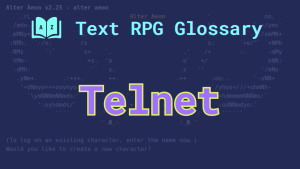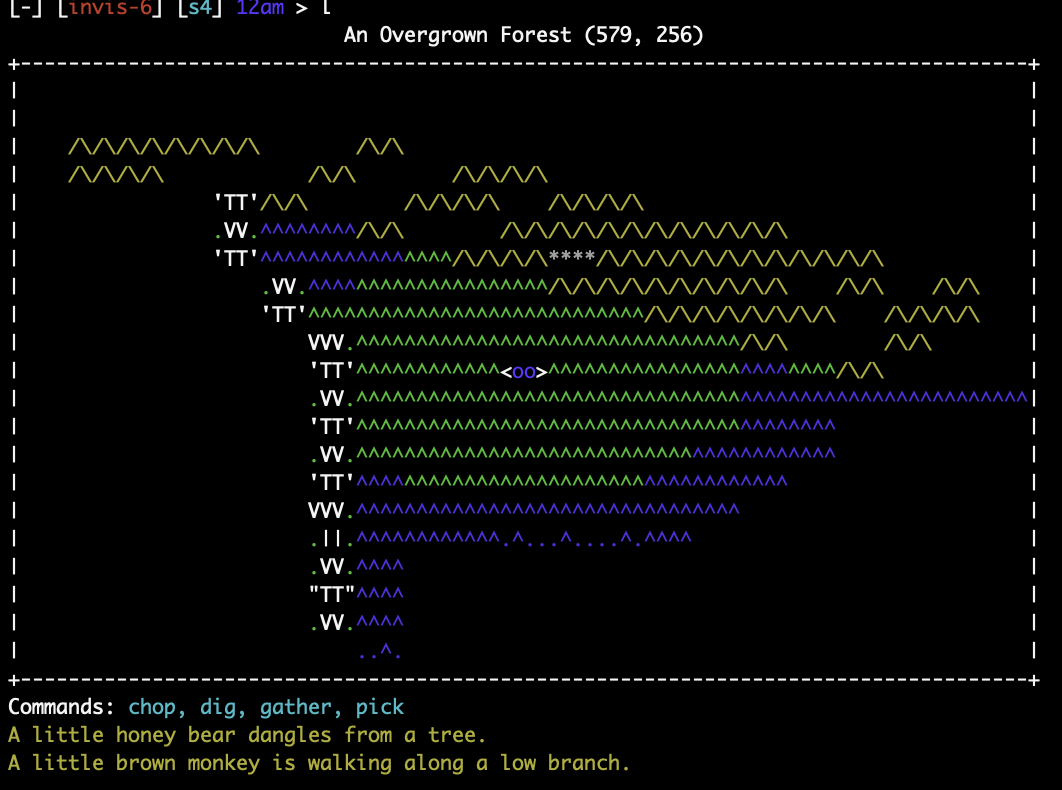What is Telnet?

Telnet is a basic way to connect to another computer over the internet using just text. In text-based roleplaying games like MUDs (multi-user dungeons), it’s often used to log into the game’s server and interact with the world by typing commands.
Players use Telnet to explore, talk, fight, and roleplay – all through words, with no graphics involved. It feels like sending instant messages to the game and getting replies in real time.
Outside of gaming, Telnet has also been used to check on servers, configure equipment, or run remote systems.
Because Telnet is a network protocol, it can be inserted into other programs. This allows developers to create new MUD clients that can connect to older games while offering a lot more features on top, such as the ability to create aliases and keyboard shortcuts, create game maps, and more.
Jump to Section
- What is Telnet?
- Telnet examples
- Myths about Telnet
- Telnet FAQs
- Is Telnet safe to use for MUDs?
- Do I need to download something to use Telnet?
- Why would anyone still use Telnet today?
- Does Telnet support colors or advanced features?
- Can I roleplay just as well on Telnet as with a fancy client?
- Can Telnet be used on mobile devices?
- What kind of games can I play using Telnet?
- Can I host my own game and let others connect via Telnet?
- Do people still create new games that use Telnet?
A brief history of the term
Telnet was created in the late 1960s, back when computers were room-sized machines and the internet as we know it didn’t exist yet. It was one of the first ways people could access a remote machine just by typing on a keyboard. Instead of needing to physically sit in front of a computer, you could “telnet in” from somewhere else and work on it as if you were there.
As MUDs started showing up in the late 1970s and early 1980s, players needed a way to connect to those game servers – and Telnet was already there. It became the default tool for accessing these games, mainly because it was built into most operating systems and required no special setup.
Over time, people developed better and more secure ways to connect to remote systems, like SSH (which encrypts data) or custom clients with advanced features. But in the world of MUDs, the simplicity of Telnet meant it never completely went away.

Modern usage
These days, you probably won’t see Telnet used in workplaces or schools unless you’re dealing with legacy systems or very specific setups. It’s considered outdated for most modern tasks, especially those that need security.
But in the gaming world – especially for fans of MUDs – it still has a role. Some players use it to log in quickly, especially if they’re on a borrowed computer or don’t want to install a full game client. Developers also use it for testing. If you just want to make sure a game server is online and accepting connections, Telnet is one of the fastest tools for the job.
It’s also a teaching tool. Some game design and computer science classes use MUDs and Telnet to help students understand how online communication works. Since there’s no fancy interface, it’s easier to focus on what’s really happening behind the scenes.
And while most players today use more advanced MUD clients that support features like color-coded text, macros, or sound effects, many of those still use the Telnet protocol underneath. It’s just hidden behind a more user-friendly interface.
Types of games that rely on Telnet include but are not limited to:
MUD, MUSH, MOO, MUCK, and Talker.
Telnet examples
- A MUD player opens a terminal and types
telnet stickmud.com 7680to jump into a medieval fantasy world with guilds, classes, and various playable races. - A student in a university game design course uses Telnet to connect to a campus-hosted roleplaying server as part of a class assignment.
- A hobbyist uses it to log into a sci-fi MUD that’s been running since the ’90s, choosing Telnet for the authentic feel of early online gaming.
- A developer checks whether a MUD server is responding by using Telnet to quickly send test commands and verify that everything’s working.
- A retro gaming fan connects to a classic fantasy MUD using Telnet because it doesn’t require installing any extra programs.
Myths about Telnet
- Telnet is completely obsolete. While it’s true that it’s no longer recommended for secure or sensitive applications, Telnet is still alive and well in hobbyist spaces. For simple tasks like connecting to a MUD or testing a server, it’s perfectly fine and still widely used.
- You can’t roleplay properly using Telnet. Not true at all. Roleplaying is about creativity and interaction – not graphics. Telnet handles real-time chat, movement, and game commands just like any client. If you can read and type quickly, you’re good to go.
- All modern systems block Telnet. It’s not blocked, just disabled by default on many systems like Windows. You can usually turn it on in your system settings or install a lightweight alternative. macOS and Linux often include it by default, or let you install it easily from the terminal.
- Telnet can’t display colors or formatting. Basic Telnet can show simple colors using ANSI codes, and many MUDs are built around that. It won’t handle things like clickable links or advanced layouts, but it still offers a surprisingly rich experience if the game is designed for it.
- Using Telnet is too hard for beginners. It might look intimidating at first because there’s no graphical interface, but it’s actually pretty simple. You just open a terminal, type a command like
telnet address port, and you’re in. If you’ve ever used a chatroom or command line, you’ll pick it up quickly.
That said, I do agree that for many first-time players, Telnet can be a barrier or deterrent to playing MUDs. Gamers today are often unfamiliar with command line interfaces and may find it tedious to have to “read up” on how to connect via terminal.
Telnet FAQs
Is Telnet safe to use for MUDs?
For casual gaming, yes. In most cases, it doesn’t encrypt your data, so it’s not secure for things like passwords or private info – but for a public game with no sensitive data, it’s totally fine. Most MUDs don’t ask for anything private anyway. (Though you might be tempted to share personal info with other players. Always use caution when sharing information about yourself on the internet.)
Do I need to download something to use Telnet?
Sometimes. Sometimes operating systems still include it but have it turned off by default – you can turn it on through system features in Windows, for example. On macOS or Linux, it’s usually pre-installed or easy to get. You can also use third-party Telnet or MUD clients, which often add color, scrollback, and custom scripts. The Mudlet MUD client is one of my favorites for this.
Why would anyone still use Telnet today?
Because it’s fast, simple, and it still works. Some players love the retro feel, while developers use it for quick testing. It’s also helpful in teaching, troubleshooting, or jumping into a game without installing anything fancy.
Does Telnet support colors or advanced features?
It supports basic colors using ANSI codes, but not much beyond that. Don’t expect clickable links or sound effects. If you want more features, use a modern MUD client – it’ll give you a nicer experience but still use the same connection method behind the scenes. You can find a list of popular clients on my MUD Resources page.

Can I roleplay just as well on Telnet as with a fancy client?
Sure! Roleplay often depends more on imagination, creativity, and good writing. You won’t have tools like command aliases or triggers, but if you’re comfortable typing fast and reading text, you can have a rich roleplay experience over Telnet. If you’re playing a player versus player (PvP) game, though, the bells and whistles of a dedicated client can really help you out.
Can Telnet be used on mobile devices?
You can, but it’s not ideal. There are Telnet apps for Android and iOS, but typing commands and reading long blocks of text on a phone screen isn’t the best experience. Still, if you really want to connect to a MUD on the go, it’s doable. You can check my MUD resources page for mobile clients (there aren’t many these days) or use a browser-based client like LociTerm.
Browser clients don’t technically use Telnet themselves (they connect to an intermediate layer), but you’ll get a similar experience: interacting with the game through text and a command line interface.
What kind of games can I play using Telnet?
Mostly text-based games like MUDs. You won’t find modern 3D games using Telnet.
Can I host my own game and let others connect via Telnet?
Yes! If you run a MUD server or similar text-based engine on your own computer or server, others can connect to it using Telnet.
Opening a port to your home computer isn’t the safest idea, however, so I recommend reaching out to Opie for free hosting or setting up on something like a Digital Ocean Droplet, instead.
Do people still create new games that use Telnet?
They do! While not as well-known, indie developers and hobbyists still build text-based games that use Telnet for the connection. It’s especially common in communities focused on retro gaming, interactive storytelling, and educational projects.




Leave a Comment